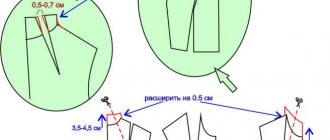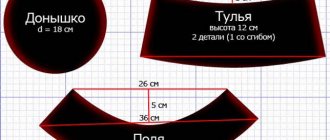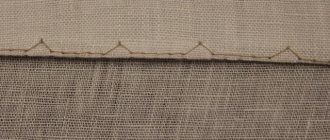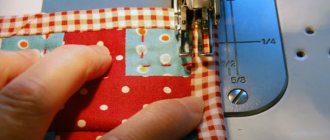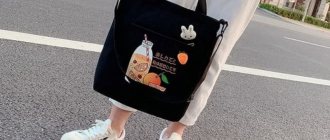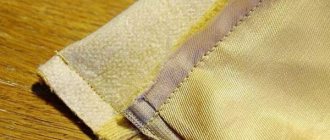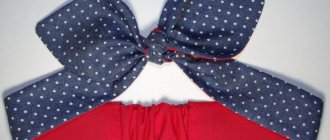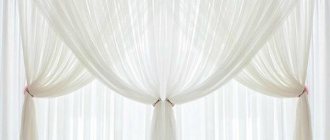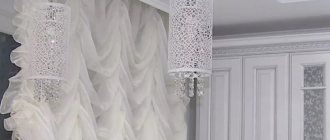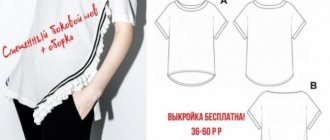Order in thoughts, work and things is a normal and necessary character trait of a modern person in the current difficult conditions of life in society. And therefore, many strive to ensure that things are in proper order and in their place. Clothes should hang in the wardrobe, and shoes should be on the shelf. This also applies to other, smaller things: cosmetics, stationery and other things. An accessory called an organizer was invented specifically for storing them. It is noteworthy that making it from fabric or other, denser material is not difficult even for novice craftswomen. This article will tell you how to sew a hanging organizer for things with your own hands and what main types of storage containers exist.
What is an organizer and why is it needed?
An organizer is a special stand with compartments (box, drawer), which, as you can guess from the name, is designed for storing small items (cosmetics, office supplies, etc.). It helps not only to put things in a pile, but to correctly distribute them by purpose and color. Organizers have become very popular recently due to their widespread use in the West. Today, a variety of models are produced for pens and pencils, tools, and underwear.
Office supplies and other small items fit well in wooden organizers
The organizer itself is a container with cells for convenient storage and optimization of free space. It can be flat and small, or it can be large and roomy. If you plan to purchase, you should find out its features or make such a chest yourself. A homemade organizer looks stylish and fits into the overall interior of the room.
Great solution for the hallway
Main types of organizers
There are several main types of organizers:
- wall (boards or other shelves);
- tabletop (stands with compartments);
- “drawer” type (dividers inside regular dresser drawers).
There are a huge number of models made of wood, plastic, acrylic or even metal on the organizer market. Not all of them may be suitable for a particular person, since his shelves may be too narrow and his table may be small. If you make the devices yourself, you won’t have to guess about the sizes.
You might be interested in this Instructions for manual sewing machines Podolsk with foot drive
Important! It is also noteworthy that these interior items can be made from almost any material at hand.
Using clothespins to store headphones
How to sew a travel organizer for cosmetics from fabric
Organizers for cosmetics are made mainly from textiles. Literally any fabric will do, but it is better to choose a dense and strong material that is not afraid of moisture, stretching and holds its shape well under the weight of the entire women's set of tubes and bottles.
The most suitable for going out is a case. It allows you to save space not only at home, but also in your handbag. To put it simply, a case is an ordinary fabric pocket with a clasp that has many pockets. It is convenient to fold and unfold it back. You can also secure it with a lace or ribbon.
Textile compact organizer
Sewing such a device is very simple, since it is made from a single piece of fabric, processed along the edges and containing many pockets for pencils, mascara and lipstick. Another option is a box. It can tidy up your workplace and can be stored anywhere.
Manufacturing materials
For making pockets in cabinets, a fabric that retains its shape well is suitable. Its color should be attractive to the child, with a cheerful pattern or plain if you plan to apply an applique. The following types of materials are used in the manufacture of the organizer:
- water-repellent fabric (tarpaulin, raincoat);
- thick textiles or cotton;
- thin plastic sheet.
More practical is water-repellent material or plastic. The first one washes well and gets dirty a little. To remove light stains, you can simply clean the organizer with a damp soapy sponge and let it dry. It is difficult to make a plastic product at home, but such pockets can be purchased in specialized stores. They are more convenient to clean, since they can be washed directly on the door. Kindergartens often purchase just such options. If parents have needlework skills, then you can sew the pockets yourself.
How to make a fabric organizer
You can quickly make an original and beautiful organizer with your own hands from a simple piece of fabric. It is especially suitable for hairpins, tools, underwear or cosmetics. You will need:
- a piece of dense material;
- cardboard;
- threads;
- needle or sewing machine;
- ruler.
Convenient storage of cosmetics
Step-by-step instructions are as follows:
- A rectangle is cut out of fabric. Its size depends on the desired size of the organizer;
- the edges of the cut are sewn on a machine;
- a loop is sewn on, with which it will be attached to a wall or cabinet;
- Rectangles for future pockets are made from the same fabric. You can make them in different sizes and degrees of depth;
- determine the location of parts;
- Sew the pockets to the fabric using a needle or machine.
Important! If you wish, you can decorate the device. Children can also happily help with this, because they always want to demonstrate their creative talents.
Accessory for crib
Car organizer made from jeans
This device is characterized by increased reliability and simplicity, because it is made of dense and strong denim fabric. You can buy a special piece for this, but it would be much more practical to make a product from old pants. In this case, you can use not only back pockets, but also belt loops, which will serve as fastening elements for round objects.
You might be interested in How measurements are taken for sewing men's trousers and clothing
Seat back option
There are many options for making a device made from pants. You can leave the back part to the knees, and cut off the remaining legs and sew them in the form of additional pockets. Another option involves sewing the pants into a rectangle and sewing on the compartments. In any of these cases, it is necessary to provide for mounting on the rear surface of the car seat or on its cover.
Decor options
Each cabinet and its hanging pockets are individual. To make the organizer bright, you can use fabric with checkered, striped, polka dots, flowers or stars. If you decide to stick to a plain base for the product, then the finished pockets can be decorated:
- buttons, rhinestones (it is better not to use small parts for safety reasons);
- ribbons and bows, lace;
- applique, stripes, embroidery;
- images of cartoon characters and animals;
- the base can be the same color, the pockets are decorated with a pattern.
The right combination and reasonable selection of decor is important. You should not use many small decorative elements on fabrics with a ready-made pattern. If the base is monochromatic, it can be diversified with a combination of contrasting colors.
We sew an organizer for a needlewoman
An organizer for a needlewoman requires special compartments for needles, threads, scissors and other paraphernalia. Fastenings are best made from rubber bands. To work you will need:
- three pieces of felt 30 by 45 cm;
- floss melange;
- elastic band or rubber band;
- zipper for closing the organizer (30 cm);
- buttons;
- elastic cord;
- needles and scissors.
Organizer case for cosmetics made of fabric
Sewing starts from the inside. A line is marked on the cut at a distance of 2 cm from the edge for inserting a zipper on the reverse side. Elastic bands or elastic bands are sewn next to or below. Its slots can also be hidden under felt.
Next, additional pockets are made from the same fabric. They can be closed with rivets or buttons. Once you're done, you can sew the inside piece to the other piece to hide the back of the zipper and the seams. If desired, you can also decorate the organizer with embroidery, appliqués and other decorative elements.
The process of collecting containers for a needlewoman
Stages of work
A ready-made frame can be purchased at an art store or hardware supermarket, but it must be uncoated in order to be able to paint the product in the desired color.
The painting process is carried out first, for which two layers of paint are applied with short breaks (about 1 hour) so that the first layer has time to dry well. A layer of varnish must be applied to the dried paint.
Do not forget that after each stage it is advisable to clean the brush of paint, especially before applying varnish.
A piece of beautiful fabric, lace or a regular picture is inserted into the frame, which will become the background for the future organizer.
The decorations will be held on by ropes (ribbons) or self-tapping screws. Sections of rope along the length of the frame are located along the product and secured either with a stapler or glue.
You can hammer in 2 small nails on each side and simply pull the rope over them. Large nails, metal hooks and baskets can serve as jewelry holders.
At the last stage, you need to secure the loop with a self-tapping screw in order to hang the picture on the wall. The jewelry organizer is ready!
Headphone organizer
Headphones can also be cleverly folded into the organizer. You can make it yourself from a variety of objects and materials:
- ordinary wooden clothespins;
- paper and old bank cards;
- felt and other fabric;
- oilcloth, leather or its substitute.
The easiest way is to use two wooden clothespins. They are opened, painted and decorated as desired and glued to each other on different sides. You can easily wrap the wires around clothespins and secure their ends.
Pattern in the form of a paw
A plastic card cut out in the shape of a fish skeleton also makes a good organizer. It contains two clips along the edges to secure the headphones. You can make a device according to the example in the picture.
Important! The felt or leather product usually looks like a stuffed toy or pillow with clasps for wires. You can do it according to schemes that are found in abundance on the Internet.
You might be interested in Dress patterns with frills and elastic bands on the shoulders
Organizer in the shape of a fish
Branch processing
After the pockets are made, you need to decorate them. The easiest way to do this is to stick appliques with fairy-tale characters. It will look beautiful if beautiful embroidery is done on the pockets in advance. The appliqués are attached before the pocket is sewn on.
You might be interested in: Creating a pattern and sewing a beanbag chair with your own hands according to the instructions
Step-by-step instructions for processing pockets are as follows. The lower side edges are folded into a deep fold. This is necessary to give the pockets volume. To make flaps to close the pockets, they are cut in a trapezoid shape and sewn to the base at the wider part. For fastening, it is convenient to use a Velcro-type connection.
Decorated with appliqués
Wall pocket
Another type of organizer is a simple pocket-bag that is mounted on the wall. Its advantage is that it can be made from almost anything that comes to hand. The production itself will take no more than half an hour.
It also has disadvantages. It is not divided into compartments, as a result of which things will be mixed in it. An ideal hanging pocket is suitable for similar items: spools of thread, balls, small toys, tools.
Simple pocket
DIY wall organizer made from jeans
This option is similar to the one made for a car. It uses torn or cut pockets, which are then sewn onto a piece of denim from old pants. Such a thing helps not only adults, but also children, who can not throw their toys around the room, but carefully put them in pockets. This accustoms people to cleanliness and order.
Wall denim option
Important! The fabric organizer can also be used in the bathroom. It holds shampoos, toothpaste or combs. For wet places, of course, it is preferable to use maple or leather instead of fabric, since the canvas will quickly get wet from water and steam.
Varieties
In order for the child to have everything he needs, there should be room in the pockets on the locker, for example, for the following things :
- socks;
- T-shirt;
- tights;
- sweater;
- handkerchief.
You may need not only these, but also many other things that are convenient to store in special pockets (for example, a comb, hairpins for a girl). Of course, these things can be folded into a neat pile or placed in a bag, but using pockets is much more convenient.
Usually they are sewn onto fabric and hung on the door of the cabinet in which clothes are stored.
Pockets with various methods of attachment to the door are used. The following options may apply:
- The most common is the use of eyelets or loops. They are hung on screws screwed into the cabinet door, or hooks attached to it.
- You can use an elastic band for fastening. In this case, there is no need to install hooks or hammer nails. Therefore, this method is convenient, but the elastic pockets will sag.
- Can be attached with adhesive tape. To secure it more securely, it is bent over the top edge of the door.
- You can use double-sided tape to hang the pockets. This method will be convenient in cases where it is not possible to screw screws into the door or attach hooks.
Each pocket can be made open or closed. The following options can be used:
- Using buttons or Velcro.
- Make sure that the elastic bands go through the top edge.
- Sometimes open pockets are suitable.
- It will be beautiful if they are decorated with embroidery or appliqués depicting your favorite cartoon characters.
- To attach to the door, it is convenient if the fabric with pockets is folded to the outside of the door. In this case, it will be possible to attach a recognizable picture on the outside for each child and write his name.
For your information! This will allow the kindergarten teacher to easily find the things of a particular child, and the child to find out at first glance where his things are stored.
The models used can be distinguished by pocket sizes:
- Large pockets can be used (for which old jeans are used, for example), occupying the entire door or most of it.
- Sometimes they are made of medium size, the size of half a door or a little larger.
- It is common to use models that use several small pockets.
Note! When choosing how to sew pockets for a kindergarten in a locker yourself, you need to take into account that a small number of pockets will not allow you to efficiently organize the storage of your baby’s things, and too small ones will not always allow you to find enough space for larger, replaceable things.
Other types of needlework
You can also assemble a “storage” for your accessories from solid materials. Plastic, acrylic or wood are often used for this. These options are ideal for placing them in a cabinet, on a table or shelf. They save space and allow you to keep all the necessary items at arm's length.
All you need to make them is wooden slats or boards, plywood and nails, which can be replaced with reliable glue. Finding plastic parts is a little more difficult, but they are much easier to work with.
Flat floor (hover) for a car
Thus, it was told how to sew an organizer for storing things with your own hands (hanging and tabletop), as well as what types of these devices there are. If you wish, you can find many master classes on sewing or even knitting an organizer. Its great popularity is explained by its versatility, because the product can be used in the car, in its trunk, in the children's room and in the bathroom.
